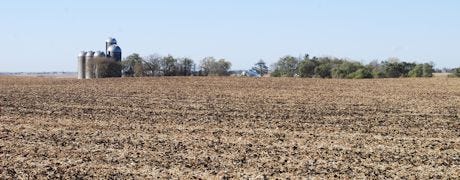
If you farmed in the early 1990s era or before, you remember the different years when herbicide carryover was an issue. It's linked more so to residual herbicides. The dramatic switch to Roundup Ready crops in the late 1990s made it somewhat of a moot issue. Now, more farmers are applying residual herbicides again to combat weed resistance.

INJURY RISK: Drought affects the rate of breakdown of herbicides in soil. Carryover of certain herbicides could cause problems for sensitive crops in 2013. Risk of carryover injury will vary widely from field to field depending on several factors. It's important to evaluate each field individually to determine risk of injury.
Enter the drought of 2012. It's prompting the need for farmers and their crop consultants to rethink herbicide chemistry related to potential carryover and how to avoid damage to the following crop. The dry conditions that prevented residual herbicides from providing effective weed control also make carryover a possibility, notes Mike Owen, an Iowa State University Extension weed scientist.
The active ingredients in herbicides vary dramatically in how fast they break down in the soil, he explains. For example, thifensulfuron has very little persistence. Picloram can hang around for several months. Even within the same chemical family, persistence varies. In the imidazolinone family, imazamox persists for a much shorter time in the soil than imazethapyr.
Carryover concerns for 2013, one of the consequences of this year's drought
But what if you get enough rainfall by spring? Won't that remove the carryover risk? Not necessarily, says Owen. Time is a big part of this too, as are other factors such as soil pH and the particular herbicide, application rate and date you applied it. Sensitivity of the rotational crop to injury risk is another consideration.
“Reduced herbicide degradation is one of the consequences of the current drought," Owen warns. “It could lead to damage in rotational crops next spring. The risk of carryover injury will vary widely from field to field, making it important to evaluate each field individually as you plan ahead this fall."
~~~PAGE_BREAK_HERE~~~
In some situations, this prolonged persistence will lead to damage to the rotational crop, so you may want to plant a different crop in that field. Owen and Bob Hartzler, another Extension weed management specialist at ISU, have put together a list of factors farmers and crop advisers can use to help determine risk of carryover injury to the rotational crop in a field.
Factors determining the risk of carryover injury include:
* chemical half-life
* rate of herbicide applied
* application date
* soil characteristics (texture, organic matter, pH)
* rainfall (total amount and distribution throughout year)
* sensitivity of rotational crop
* growing conditions following planting next spring
The relative persistence (half-life) and the rate of herbicides used in the field have the greatest impact on the likelihood of herbicide residues injuring the following sensitive crop. However, Owen also says you should keep in mind that only a few of the herbicide active ingredients used in corn and soybean production today have characteristics that may lead to carryover problems in 2013.
Herbicides with carryover potential
High Risk
atrazine (numerous products)
chlorimuron (Authority XL, Canopy, Envive, Valor XLT, others)
imazaquin (Scepter)
simazine (Princep, others)
Moderate to Slight Risk
fomesafen (Reflex, Flexstar, Prefix)
clopyralid (Hornet)
cloransulam (FirstRate, Hornet, Gauntlet, etc.)
imazethapyr (Pursuit)
Dinitroanilines
pendimethalin (Prowl, others)
trifluralin (Treflan, others)
HPPD Inhibitors
isoxaflutole (Balance Flexx)
mesotrione (Callisto, Lumax, Lexar)
tembotrione (Laudis, Capreno)
topramezone (Impact)
~~~PAGE_BREAK_HERE~~~
The products listed as High Risk have the potential to damage rotational crops under 'normal' conditions. “Most farmers have learned what rates can be used on their soils safely, but this year's drought will result in a high risk even if reduced rates were applied," says Owen. Owen and Hartzler offer the following observations and recommendations.
Both chlorimuron and atrazine are more persistent in high pH soils. Preemergence applications of chlorimuron will have a much higher risk of problems because these rates are much higher than when chlorimuron is applied postemergence (Classic). In certain situations, the best option may be to alter your crop rotation plans to avoid planting a susceptible crop.
Products listed in the 'Moderate to Slight Risk' category have been known to occasionally cause problems or have half-lives that suggest they might cause problems under abnormal conditions. Risks with these products will vary widely from field to field depending on the specific conditions encountered.
Evaluate risk field-by-field for potential damage to sensitive rotational crops
To minimize problems next spring, evaluate this year's herbicide program for compounds that pose a carryover risk. Consider rates, application date, soil characteristics and label restrictions.
Keep in mind that if rainfall returns to normal, this rain will have much less effect on herbicide degradation than had it occurred near the time of herbicide application.
What about tillage? While tillage should dilute herbicide residues within the soil profile, past experience has shown that this practice does not consistently reduce crop injury from herbicide residues. The conditions a crop experiences during establishment greatly influence its ability to tolerate residual concentrations of herbicides. Using practices that minimize additional stresses to the crop seedling (such as planting date, seedbed conditions, etc.) can reduce problems associated with low concentrations of herbicides that carryover in the soil.
For weed management information visit the ISU Extension weed science website.
About the Author(s)
You May Also Like




